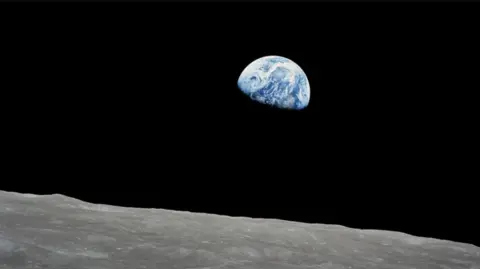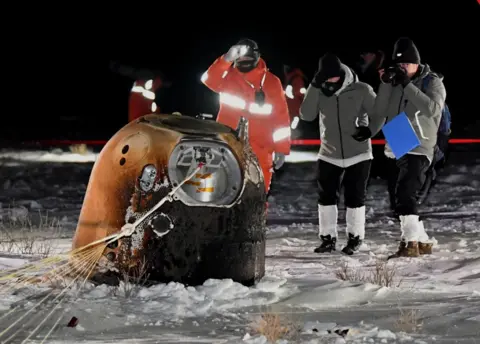Foreign News
Senate’s $95bn for Ukraine, Israel and Taiwan faces uphill battle in House

The US Senate has approved a $95bn (£75.2bn) aid package for Ukraine, Israel and Taiwan after months of political wrangling.
While Democrats were in favour of passing the bill, Republicans were divided and previously voted it down. The package includes $60bn for Kyiv, $14bn for Israel’s war against Hamas and $10bn for humanitarian aid in conflict zones, including in Gaza.
The bill will now go to the House, where its fate is uncertain.
The package, which also includes more than $4bn in funds for Indo-Pacific allies, passed the Senate despite criticism from Republican House Speaker Mike Johnson and former President Donald Trump. Lawmakers voted 70 to 29 to approve the package. Twenty-two Republicans, including Senate Minority Leader Mitch McConnell, joined most Democrats to vote for the legislation.
“History settles every account,” Mr McConnell, a Kentucky senator, said in a statement following the vote. “And today, on the value of American leadership and strength, history will record that the Senate did not blink.”
Ukraine’s leader said he was “grateful” to senators. “For us in Ukraine, continued US assistance helps to save human lives from Russian terror. It means that life will continue in our cities and will triumph over war,” President Volodymyr Zelensky wrote in a post on X, formerly Twitter.
The vote came after an all-night Senate session during which several Republican opponents made speeches in a bid to slow down the process. “Shouldn’t we try to fix our own country first?” Senator Rand Paul of Kentucky said on Monday. Some left-wing lawmakers, including Democrat Jeff Merkley of Oregon and independent Bernie Sanders of Vermont, also voted against the bill, citing concerns about supporting Israel’s bombing of Gaza.
The aid package is a stripped-down version of a $118bn package that Senate Republicans voted down last week.
Republicans had initially demanded that any foreign aid be tied to more security measures at the southern border. But after Mr Trump came out against the border provisions, Republicans were divided on the package. Some lawmakers suggested border measures could be added back into the current version of the legislation.
Mr Johnson suggested in a statement on Monday night the new bill would not pass the Republican-controlled House of Representatives without such provisions. “House Republicans were crystal clear from the very beginning of discussions that any so-called national security supplemental legislation must recognise that national security begins at our own border,” he said.
The Louisiana congressman said lawmakers “should have gone back to the drawing board” with the legislation to focus on border security.
With Senate passage of the aid bill stripped of immigration measures, Mr Johnson and the House Republican leadership will have to decide whether to bring the package to a vote in that chamber, attempt to amend it and send it back to the Senate, or to ignore it entirely.
That last option could prompt those House Republicans who support Ukraine military assistance to join Democrats in filing a discharge petition. This is a rare parliamentary procedure that would circumvent Mr Johnson and force a vote.
Some on the left may baulk at the military aid for Israel in the package, however, making such a manoeuvre – which requires the support of a majority of the House – more difficult.
After the Senate vote, Mr Johnson said his chamber “will have to continue to work its own will on these important matters”. He could divide the different pieces of aid into separate components, or add conservative US immigration reforms. Mr Johnson will be hard-pressed to convince his narrow House majority, which is sharply divided on aid to Ukraine, to follow his lead, however.
Democratic Senate Majority Leader Chuck Schumer, meanwhile, hailed the passage of the bill on Tuesday. He said the Senate was “telling Putin he will regret the day he questioned America’s resolve”.
President Joe Biden applauded the measure, too, saying it would allow the US “to stand up for Ukraine’s freedom and support its ability to defend itself against Russia’s aggression”.
The US is one of the largest providers of aid to Ukraine. The White House asked Congress months ago to pass a bill that included foreign aid.
This could be Congress’s last shot at passing Ukraine aid for the foreseeable future, and Ukraine has warned it may not be able to successfully defend itself against Russia without Washington’s backing.
(BBC)
Foreign News
Nasa ‘Earthrise’ astronaut dies at 90 in plane crash

Apollo 8 astronaut Bill Anders, who snapped one of the most famous photographs taken in outer space, has died at the age of 90.
Officials say a small plane he was flying crashed into the water north of Seattle, Washington.
Anders’ son Greg confirmed that his father was flying the small plane, and that his body was recovered on Friday afternoon. “The family is devastated. He was a great pilot. He will be missed,” a statement from the family reads.
Anders – who was a lunar module pilot on the Apollo 8 mission – took the iconic Earthrise photograph, one of the most memorable and inspirational images of Earth from space.
Taken on Christmas Eve during the 1968 mission, the first crewed space flight to leave Earth and reach the Moon, the picture shows the planet rising above the horizon from the barren lunar surface.
Anders later described it as his most significant contribution to the space programme.

The image is widely credited with motivating the global environmental movement and leading to the creation of Earth Day, an annual event to promote activism and awareness of caring for the planet.
Speaking of the moment, Anders said: “We came all this way to explore the Moon, and the most important thing that we discovered was the Earth.”
Officials said on Friday that Anders crashed his plane around 11:40PDT (1940BST).
The US National Transportation Safety Board (NTSB) said the 90-year-old was flying a Beechcraft A A 45 – also known as a T-34. The agency said that the plane crashed about 80ft (25m) from the coast of Jones Island.
Anders also served as the backup pilot to the Apollo 11 mission, the name of the effort that led to the first Moon landing on July 24, 1969.
Following Anders’ retirement from the space programme in 1969, the former astronaut largely worked in the aerospace industry for several decades. He also served as US Ambassador to Norway for a year in the 1970s.
But he is best remembered for the Apollo 8 mission and the iconic photograph he took from space.
“In 1968, during Apollo 8, Bill Anders offered to humanity among the deepest of gifts an astronaut can give. He traveled to the threshold of the Moon and helped all of us see something else: ourselves,” Nasa Administrator Bill Nelson said in a statement.
Mark Kelly, a former astronaut who now serves as a US Senator for the state of Arizona, said in a post on X, formerly Twitter, that Anders “inspired me and generations of astronauts and explorers. My thoughts are with his family and friends”.
[BBC]
Foreign News
China’s Chang’e-6 lifts off from far side of Moon with rock samples

A Chinese spacecraft carrying rock and soil samples from the far side of the Moon has lifted off from the lunar surface to start its journey back to Earth, according to state media.
The achievement on Tuesday is a world first and the latest leap for Beijing’s decades-old space programme, which aims to send a crewed mission to the Moon by 2030.
The Xinhua News Agency, citing the China National Space Administration (CNSA), said that the ascender of the Chang’e-6 probe took off at 7:38am local time on Tuesday (23:38 GMT) and entered a preset orbit around the moon.
It described the move as “an unprecedented feat in human lunar exploration history”.
The Chang’e-6 probe was launched last month and its lander touched down on the far side of the Moon on Sunday. It used a drill and robotic arm to dig up soil on and below the Moon’s surface, according to Xinhua.
After successfully gathering its samples, the Chang’e-6 unfurled China’s national flag for the first time on the far side of the Moon, it said.
The agency cited the CNSA as saying that the spacecraft stowed the samples it had gathered in a container inside the ascender of the probe as planned.
[Aljazeera]
Foreign News
China says its spacecraft lands on Moon’s far side

China says its uncrewed craft has successfully landed on the far side of the Moon – an unexplored place almost no-one tries to go.
The Chang’e 6 touched down in the South Pole-Aitken Basin at 06:23 Beijing time on Sunday morning (22:23 GMT Saturday), the China National Space Administration (CNSA) said.
Launched on 3 May, the mission aims to collect precious rock and soil from this region for the first time in history. The probe could extract some of the Moon’s oldest rocks from a huge crater on its South Pole.
The landing was fraught with risks, because it is very difficult to communicate with spacecraft once they reach the far side of the Moon. China is the only country to have achieved the feat before, landing its Chang’e-4 in 2019.
After launching from Wenchang Space Launch Center, the Chang’e 6 spacecraft had been orbiting the Moon waiting to land. The lander component of the mission then separated from the orbiter to touch down on the side of the Moon that faces permanently away from Earth.
During the descent, an autonomous visual obstacle avoidance system was used to automatically detect obstacles, with a visible light camera selecting a comparatively safe landing area based on the brightness and darkness of the lunar surface, the CNSA was quoted as saying by state-run Xinhua news agency.
The lander hovered about 100m (328ft) above the safe landing area, and used a laser 3D scanner before a slow vertical descent. The operation was supported by the Queqiao-2 relay satellite, the CNSA said.
Chinese state media described the successful landing as an “historic moment”. The state broadcaster said “applause erupted at the Beijing Aerospace Flight Control Center” when the Chang’e landing craft touched down on the Moon early on Sunday morning.
The lander should spend up to three days gathering materials from the surface in an operation the CNSA said would involve “many engineering innovations, high risks and great difficulty”. “Everyone is very excited that we might get a look at these rocks no-one has ever seen before,” explains Professor John Pernet-Fisher, who specialises in lunar geology at the University of Manchester.
He has analysed other lunar rock brought back on the American Apollo mission and previous Chinese missions. But he says the chance to analyse rock from a completely different area of the Moon could answer fundamental questions about how planets form.
Most of the rocks collected so far are volcanic, similar to what we might find in Iceland or Hawaii. But the material on the far side would have a different chemistry . “It would help us answer those really big questions, like how are planets formed, why do crusts form, what is the origin of water in the solar system?” the professor says.
The mission aims to collect about 2kg (4.4lb) of material using a drill and mechanical arm, according to the CNSA.
The South Pole–Aitken basin, an impact crater, is one of the largest known in the solar system.
From there, the probe could gather material that came from deep inside the lunar mantle – the inner core of the Moon – Prof Pernet-Fisher says.
The Moon’s South Pole is the next frontier in lunar missions – countries are keen to understand the region because there is a good chance it has ice.

The capsule in the last Chinese moon mission, Chang’e 5, brought back soil and rocks in 2020 (BBC)
Access to water would significantly boost the chances of successfully establishing a human base on the Moon for scientific research.
If the mission succeeds, the craft will return to Earth with the precious samples on board a special return capsule.
The material will be kept in special conditions to try to keep it as pristine as possible.
Scientists in China will be given the first chance to analyse the rocks, and later researchers around the world will be able to apply for the opportunity too.
This is the second time China has launched a mission to collect samples from the Moon.
In 2020 Chang’e 5 brought back 1.7kg of material from an area called Oceanus Procellarum on the Moon’s near side.
China is planning three more uncrewed missions this decade as it looks for water on the Moon and investigates setting up a permanent base there.
Beijing’s broader strategy aims to see a Chinese astronaut walk on the moon by around 2030.
The US also aims to put astronauts back on the moon, with Nasa aiming to launch its Artemis 3 mission in 2026.
(BBC)
























